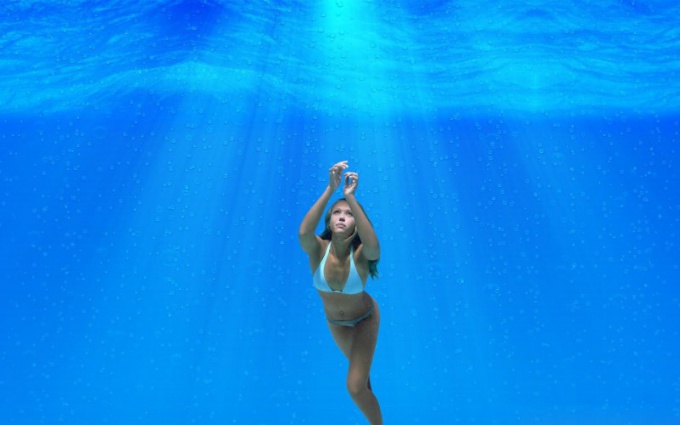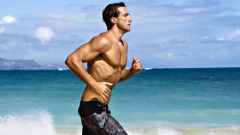In order to be able to hold breath for long time, just enough to inhale and not exhale as long as possible. And then try to improve their achievement. We need a whole range of General developmental and special exercises, which was developed by scientists and athletes from different countries.
Obesity is the main enemy of breathing. Excess weight in the body is not only a burden on the respiratory system, but excess amount of fat cells, each of which requires oxygen for its activity. Only people of normal weight can succeed in holding the breath.
Often run. Running develops the respiratory system and chest, promotes weight loss and improves the ability of the lungs to absorb oxygen. Running long distances teaches the organism to economize resources, including oxygen. Especially useful for running concentrating on the breath and teach yourself to run to a certain number of steps had a certain number of breaths.
Engage in breathing exercises described in yoga and Chinese martial arts. It is proved that they are not only well develop chest, but also learn to control the diaphragm.
Do some meditation and autogenic training. It is necessary to be able to master their emotions and disconnect from all extraneous thoughts. The ability to control oneself and not to be distracted by anything – an important component in the training of apnea.
1. Take a slow deep breath, trying to evenly fill the air the lower, middle and upper parts of the lungs. Then hold your breath for 1 minute. Do exhale with force through compressed lips, in a number of techniques. Cheeks not inflate. Over time try to increase the time of breath-holding.
2. Within a few minutes to do vigorous breaths, trying as much as possible to saturate the blood with oxygen. Then inhale and hold your breath for maximum time. While holding the breath extend hands forward at chest level, fingers squeeze into fists. Start fast to move hands back and bring them together as long as I can keep the air in the lungs. In conclusion, sharply exhale.
3. A walk concentrating on the breath. Make a certain number of steps of the same length during a slow breath. Then, without stopping, and without holding the breath, make the same number of steps on the exhale. Continue the drill until you have done several cycles of inhale-exhale. If you do the exercise easily, increase the number of steps during inhalation and exhalation. This exercise should be performed several times a day.
4. Lower breath. Lying down, place one hand on abdomen, other on chest. Start to inhale and exhale air using only the lower parts of the lungs. Hands control your breathing movement: move only the abdomen, chest should remain stationary. The exhalation should be slow through pursed lips, breath a bit shorter than the exhalation.
Immerse yourself in the water, relax and hold on to something, for example, the side of the pool. Try to disconnect from all extraneous thoughts. After a few vigorous breaths to saturate the blood with oxygen, hold your breath and dive into the water. During inhalation do not try to fill your lungs with air. The breath hold time will be much longer if you breathe in 75-80% of your maximum lung capacity. Being under water, the air in the mouth is not store.
When swimming under water try to do slow and smooth movements to save oxygen. Focus on the breath and don't let extraneous thoughts climb in the head. Looking around under water, often use peripheral vision. Do not twist once the head and don't raise it up – with a long breath, this can lead to loss of consciousness.
After a long delay of breath it is impossible to sharply exhale and inhale new air. Exhale about a third, then inhale. And then carry out a full exhale and inhale.
Remember, the warmer the water, the longer the breath hold time, as in cold water, the body requires more oxygen to maintain a constant body temperature.
During training in the water attract assistant. He was not only able to time the breath holding but insure in case of possible loss of consciousness.
General exercises
Obesity is the main enemy of breathing. Excess weight in the body is not only a burden on the respiratory system, but excess amount of fat cells, each of which requires oxygen for its activity. Only people of normal weight can succeed in holding the breath.
Often run. Running develops the respiratory system and chest, promotes weight loss and improves the ability of the lungs to absorb oxygen. Running long distances teaches the organism to economize resources, including oxygen. Especially useful for running concentrating on the breath and teach yourself to run to a certain number of steps had a certain number of breaths.
Engage in breathing exercises described in yoga and Chinese martial arts. It is proved that they are not only well develop chest, but also learn to control the diaphragm.
Do some meditation and autogenic training. It is necessary to be able to master their emotions and disconnect from all extraneous thoughts. The ability to control oneself and not to be distracted by anything – an important component in the training of apnea.
Special exercises
1. Take a slow deep breath, trying to evenly fill the air the lower, middle and upper parts of the lungs. Then hold your breath for 1 minute. Do exhale with force through compressed lips, in a number of techniques. Cheeks not inflate. Over time try to increase the time of breath-holding.
2. Within a few minutes to do vigorous breaths, trying as much as possible to saturate the blood with oxygen. Then inhale and hold your breath for maximum time. While holding the breath extend hands forward at chest level, fingers squeeze into fists. Start fast to move hands back and bring them together as long as I can keep the air in the lungs. In conclusion, sharply exhale.
3. A walk concentrating on the breath. Make a certain number of steps of the same length during a slow breath. Then, without stopping, and without holding the breath, make the same number of steps on the exhale. Continue the drill until you have done several cycles of inhale-exhale. If you do the exercise easily, increase the number of steps during inhalation and exhalation. This exercise should be performed several times a day.
4. Lower breath. Lying down, place one hand on abdomen, other on chest. Start to inhale and exhale air using only the lower parts of the lungs. Hands control your breathing movement: move only the abdomen, chest should remain stationary. The exhalation should be slow through pursed lips, breath a bit shorter than the exhalation.
Breath holding
Immerse yourself in the water, relax and hold on to something, for example, the side of the pool. Try to disconnect from all extraneous thoughts. After a few vigorous breaths to saturate the blood with oxygen, hold your breath and dive into the water. During inhalation do not try to fill your lungs with air. The breath hold time will be much longer if you breathe in 75-80% of your maximum lung capacity. Being under water, the air in the mouth is not store.
When swimming under water try to do slow and smooth movements to save oxygen. Focus on the breath and don't let extraneous thoughts climb in the head. Looking around under water, often use peripheral vision. Do not twist once the head and don't raise it up – with a long breath, this can lead to loss of consciousness.
After a long delay of breath it is impossible to sharply exhale and inhale new air. Exhale about a third, then inhale. And then carry out a full exhale and inhale.
Remember, the warmer the water, the longer the breath hold time, as in cold water, the body requires more oxygen to maintain a constant body temperature.
During training in the water attract assistant. He was not only able to time the breath holding but insure in case of possible loss of consciousness.

